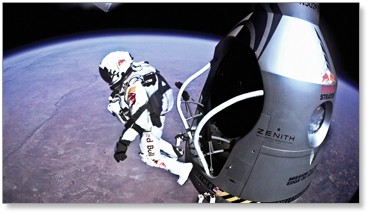Jumping From the Edge of Space

By Austin Cline
The sound barrier was first broken in 1947 by Chuck Yeager, but he had a jet airplane around him. When Felix Baumgartner broke the sound barrier on October 14, 2012, exactly 65 years after Yeager, he was only wearing a pressure suit.
Breaking Records
Baumgartner broke three world records when he jumped out of a helium balloon, floating 24 miles above the New Mexico desert. In addition to being the first to break the sound barrier without powered assistance, he also made the highest manned balloon flight and the highest skydive.
Supersonic Skydive
At 128,100 feet above the earth, Baumgartner stepped to the edge of his capsule and saw our planet from a perspective usually only experienced by astronauts. He told the eight million people watching live online: “I know the whole world is watching now. I wish you could see what I can see. Sometimes you have to be up really high to understand how small you are... I’m coming home now.”
After these words, he jumped and 42 seconds later, he reached his top speed of 833.9 miles per hour. Before a minute had passed, though, he started spinning uncontrollably. Such spins can kill skydivers by causing them to lose consciousness, but Baumgartner quickly regained control and continued the dive as planned.
After falling for four minutes and 16 seconds, he released his parachute and began to slow. His feet didn’t touch the ground until about 11 minutes after leaving his capsule. This was the culmination of a career that included over 2,500 dives, including several other world records, and now he’s “officially retired from the daredevil business.”
Scientific Benefit
Baumgartner’s jump wasn’t just about breaking records — it was also about advancing science. Much of his equipment was specially developed over many years for this project, from the capsule to the parachute itself. Now scientists know more about what breaking the sound barrier does to a person’s body and about systems that can be used to make future high-altitude jumps safer.
Because of his daring, he has pushed the boundaries of human ability and scientists have new data that will help people in the future.
Classroom Discussion
- Why might it be useful for people to be able to jump safely from the edge of space?
- What kinds of technology might make high-altitude jumps even safer?